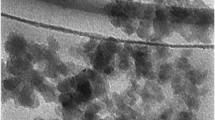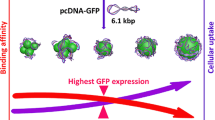Abstract
Due to the ineffective conventional treatment for hepatocellular carcinoma (HCC), the nonviral gene delivery system has been proved to be an attractive alternative to HCC therapy. In this work, we have developed a kind of new self-assembled nanoparticles, which were named as amino-modified silica nanoparticles (AMSNs). Scanning electron microscopy and zeta potential results demonstrated that AMSNs had a diameter of 20–30 nm and positive surface charges of +11.3 mV, respectively. The AMSNs could bind DNA strongly and protect DNA from degradation, which was confirmed by DNA-binding assay and serum protection assay. Furthermore, AMSNs could transfer foreign DNA into targeted cells with high transfection efficiency and little cytotoxicity. Combined with the p53 gene, AMSNs could transfect pp53-EGFP in HepG2 cells and result in a high-level of p53 mRNA and protein expressions. The nude mice treated with AMSNs/pp53-EGFP complexes showed significant tumor growth inhibition. Our results showed the AMSNs, an efficient gene vector, had the potential of gene therapy for HCC.











Similar content being viewed by others
References
Müller C. Hepatocellular carcinoma-rising incidence, changing therapeutic strategies. Wien Med Wochenschr. 2006;156:404–9.
Jen CP, et al. A nonviral transfection approach in vitro: the design of a gold nanoparticle vector joint with microelectromechanical systems. Langmuir. 2004;20:1369–74.
Welzel T, Radtke I, Meyer-Zaika W, Heumann R, Epple M. Transfection of cells with custom-made calcium phosphate nanoparticles coated with DNA. J Mater Chem. 2004;14:2213–7.
Chung TH, et al. The effect of surface charge on the uptake and biological function of mesoporous silica nanoparticles in 3T3-L1 cells and human mesenchymal stem cells. Biomaterials. 2007;28:2959–66.
Yan SF, et al. Surface-grafted silica linked with l-lactic acid oligomer: a novel nanofiller to improve the performance of biodegradable poly (l-lactide). Polymer. 2007;48:1688–94.
Kim MI, et al. Immobilization of Mucor javanicus lipase on effectively functionalized silica nanoparticles. J Mol Catal B: Enzym. 2006;39:62–8.
Park ME, Chang JH. High throughput human DNA purification with aminosilanes tailored silica-coated magnetic nanoparticles. Mat Sci Eng: C. 2007;27:1232–5.
Chiang CL, Sung CS, Chen CY. Application of silica-magnetite nanocomposites to the isolation of ultrapure plasmid DNA from bacterial cells. J Magn Magn Mater. 2006;305:483–90.
He XX, et al. Plasmid DNA isolation using amino-silica coated magnetic nanoparticles (ASMNPs). Talanta. 2007;73:764–9.
Yang W, Zhang CG, Qu HY, Yang HH, Xu JG. Novel fluorescent silica nanoparticle probe for ultrasensitive immunoassays. Anal Chim Acta. 2004;503:163–9.
Wang XY, et al. Detection of thrombin using electrogenerated chemiluminescence based on Ru(bpy) 2+3 -doped silica nanoparticle aptasensor via target protein-induced strand displacement. Anal Chim Acta. 2007;598:242–8.
Kneuer C, et al. Silica nanoparticles modified with aminosilanes as carriers for plasmid DNA. Int J Pharm. 2000;196:257–61.
Hussain SP, Schwank J, Staib F, Wang XW, Harris CC. TP53 mutations and hepatocellular carcinoma: insights into the etiology and pathogenesis of liver cancer. Oncogene. 2007;26:2166–76.
Staib F, Hussain SP, Hofseth LJ. TP53 and liver carcinogenesis. Hum Mutat. 2003;21:2012–6.
Guan YS, La Z, Yang L, He Q, Li P. p53 gene in treatment of hepatic carcinoma: status quo. World J Gastroenterol. 2007;13:985–92.
Haupt S, Haupt Y. Importance of p53 for cancer onset and therapy. Anticancer Drug. 2006;17:725–32.
Plumeré N, Speiser B. Redox-active silica nanoparticles: part 2. Photochemical hydrosilylation on a hydride modified silica particle surface for the covalent immobilization of ferrocene. Electrochim Acta. 2007;53:1245–52.
Major RC, Zhu XY. Two-step approach to the formation of organic monolayers on the silicon oxide surface. Langmuir. 2001;17:5576–80.
Varbiro G, Veres B, Gallyas F Jr, Sumegi B. Direct effect of taxol on free radical formation and mitochondrial permeability transition. Free Radic Biol Med. 2001;31:548–58.
He QQ, et al. Cell transformation and proteome alteration in QSG7701 cells transfected with hepatitis C virus non-structural protein 3. Acta Biochim Biophys Sin. 2007;39:751–62.
Sadasivan S, Rasmussen DH, Chen FP, Kannabiran RK. Preparation and characterization of ultrafine silica. Colloid Surface A. 1998;132:45–52.
Chen Y, et al. Sodium chloride modified silica nanoparticles as a non-viral vector with a high efficiency of DNA transfer into cells. Curr Gene Ther. 2003;3:273–9.
He XX, et al. A novel DNA-enrichment technology based on aminomodified functionalised silica nanoparticles. J Disper Sci Technol. 2003;24:633–40.
Zhu SG, et al. Poly(l-lysine)-modified silica nanoparticles for the delivery of antisense oligonucleotides. Biotechnol Appl Bioc. 2004;39:179–87.
Bianco A, Kostarelos K, Partidos CD, Prato M. Biomedical applications of functionalized carbon nanotubes. Chem Commun. 2005;5:571–7.
El Far MA, Atwa MA, Yahya RS, El Basuni MA. Evaluation of serum levels of p53 in hepatocellular carcinoma in Egypt. Clin Chem Lab Med. 2006;44:653–6.
Horowitz J. Adenovirus-mediated p53 gene therapy: overview of preclinical studies and potential clinical applications. Curr Opin Mol Ther. 1999;1:500–9.
Guo Y, et al. Therapeutic potential of recombinant adenovirus expressing p53 in hepatocellular carcinoma cell lines. Zhonghua Ganzangbing Zazhi. 2001;9:S43–5.
Wang W, Rastinejad F, El-Deiry WS. Restoring p53-dependent tumor suppression. Cancer Biol Ther. 2003;2:S55–63.
Nowling T, Desler M, Kuszynski C, Rizzino A. Transfection of embryonal carcinoma cells at efficiency using liposome-mediated transfection. Mol Reprod Dev. 2002;63:309–17.
Acknowledgments
This work was supported by grants from the National Natural Science Foundation of China (grant no. 20376085) and the Hunan National Science Foundation (grant no. 09JJ5030).
Author information
Authors and Affiliations
Corresponding author
Rights and permissions
About this article
Cite this article
Xiao, X., He, Q. & Huang, K. Novel amino-modified silica nanoparticles as efficient vector for hepatocellular carcinoma gene therapy. Med Oncol 27, 1200–1207 (2010). https://doi.org/10.1007/s12032-009-9359-9
Received:
Accepted:
Published:
Issue Date:
DOI: https://doi.org/10.1007/s12032-009-9359-9




